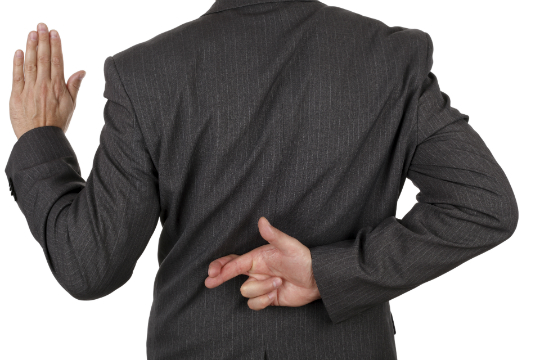It's not all facial tics and pupil dilation, the lying game. Jamie Lawrence draws inspiration from a TED talk he saw recently.
This list was adapted from Pamela Meyer’s TED talk on spotting liars. Pamela is author of Liespotting.
First, some nice quotes from Pamela:
- “A lie has no power whatsoever by its mere utterance; its power emerges when someone else agrees to believe the lie.”
- “If you’re in an average married couple, you’re going to lie to your spouse in one out of every 10 interactions.”
- “Lying is a cooperative act.” Watch this talk » “Lying is an attempt to bridge a gap, to connect our wishes and our fantasies, about who we wish we were, how we could be, with what we’re really like.”
Verbal cues of dishonesty
- Resorting to formal language e.g. ‘did not’ rather than ‘didn’t.’
- Distancing language e.g. “that woman” rather than using a name
- Qualifying language e.g. “in all candour” or “to be frank”
- Repetition of the question or furnishing with too many details
Body language slips
Freud: “If his lips are silent, he chatters with his fingertips.”
“We can rehearse our tells but we rarely rehearse our gestures.”
- Freezing their upper bodies (contrary to popular belief, liars don’t tend to fidget)
- Maintaining too much eye contact (contrary to popular belief, liars aren’t afraid of looking in your eyes)
- Withdrawn, often look down
- Head shakes when nodding
- Flashes of emotion e.g. ‘duper’s delight’ which refers to micro-expressions of smiles when a person is enjoying the act of deception
- Shifting blinking rate
- Point feet towards an exit
- Put barrier objects between themselves and their accuser
- Alter vocal tone, often making it much lower
Honest v untruthful responses
- Honest people will be co-operative and show they are on your side, willing and helpful to get you to the truth, willing to brainstorm and provide insight. They will often be furious if falsely accused – and this will happen throughout the ENTIRE incident, rather than in flashes
- Honest people will answer the question “what should happen to the person who did this bad thing?” with a stricter punishment than the person who actually did the thing
- Dishonest people will pepper their story with too much detail and irrelevant places. And they’ll tell their story in chronological order. Trained investigators, over the course of several hours, will ask the person to tell their story backward, and will then see which question produced the highest number of deceptive tells.
- Dishonest people will make an expression while masking another that leaks through in a flash – murderers are known for ‘leaking sadness.’
The importance of identifying contempt
When anger turns to contempt, you’ve been dismissed. Contempt is marked by one lip corner turned up and in. It’s the only asymmetrical expression and in the presence of contempt, you should end the interaction and whatever future outcome you were chasing – although it doesn’t normally follow that deception follows.
Note: The behaviours listed in this article are just behaviours – they are NOT proof of deception, they are red flags. They don’t mean anything in and of themselves, but it’s when you see clusters they become meaningful. Have dignity if you think someone is lying – ask them questions and observe but never assume. Another point we need to be aware of is that, particular in this social, connected world we live in, is that qualities such as oversharing, transparency and informality are NOT in themselves signs of honesty.
The article was first published by Jamie Lawrence, editor of our sister site HRzone, the home of HR.
It's not all facial tics and pupil dilation, the lying game. Jamie Lawrence draws inspiration from a TED talk he saw recently.
This list was adapted from Pamela Meyer’s TED talk on spotting liars. Pamela is author of Liespotting.
First, some nice quotes from Pamela:
- “A lie has no power whatsoever by its mere utterance; its power emerges when someone else agrees to believe the lie.”
- “If you’re in an average married couple, you’re going to lie to your spouse in one out of every 10 interactions.”
- “Lying is a cooperative act.” Watch this talk » “Lying is an attempt to bridge a gap, to connect our wishes and our fantasies, about who we wish we were, how we could be, with what we’re really like.”
Verbal cues of dishonesty
- Resorting to formal language e.g. ‘did not’ rather than ‘didn’t.’
- Distancing language e.g. “that woman” rather than using a name
- Qualifying language e.g. “in all candour” or “to be frank”
- Repetition of the question or furnishing with too many details
Body language slips
Freud: “If his lips are silent, he chatters with his fingertips.”
“We can rehearse our tells but we rarely rehearse our gestures.”
- Freezing their upper bodies (contrary to popular belief, liars don’t tend to fidget)
- Maintaining too much eye contact (contrary to popular belief, liars aren’t afraid of looking in your eyes)
- Withdrawn, often look down
- Head shakes when nodding
- Flashes of emotion e.g. ‘duper’s delight’ which refers to micro-expressions of smiles when a person is enjoying the act of deception
- Shifting blinking rate
- Point feet towards an exit
- Put barrier objects between themselves and their accuser
- Alter vocal tone, often making it much lower
Honest v untruthful responses
- Honest people will be co-operative and show they are on your side, willing and helpful to get you to the truth, willing to brainstorm and provide insight. They will often be furious if falsely accused – and this will happen throughout the ENTIRE incident, rather than in flashes
- Honest people will answer the question “what should happen to the person who did this bad thing?” with a stricter punishment than the person who actually did the thing
- Dishonest people will pepper their story with too much detail and irrelevant places. And they’ll tell their story in chronological order. Trained investigators, over the course of several hours, will ask the person to tell their story backward, and will then see which question produced the highest number of deceptive tells.
- Dishonest people will make an expression while masking another that leaks through in a flash – murderers are known for ‘leaking sadness.’
The importance of identifying contempt
When anger turns to contempt, you’ve been dismissed. Contempt is marked by one lip corner turned up and in. It’s the only asymmetrical expression and in the presence of contempt, you should end the interaction and whatever future outcome you were chasing – although it doesn’t normally follow that deception follows.
Note: The behaviours listed in this article are just behaviours – they are NOT proof of deception, they are red flags. They don’t mean anything in and of themselves, but it’s when you see clusters they become meaningful. Have dignity if you think someone is lying – ask them questions and observe but never assume. Another point we need to be aware of is that, particular in this social, connected world we live in, is that qualities such as oversharing, transparency and informality are NOT in themselves signs of honesty.
The article was first published by Jamie Lawrence, editor of our sister site HRzone, the home of HR.








